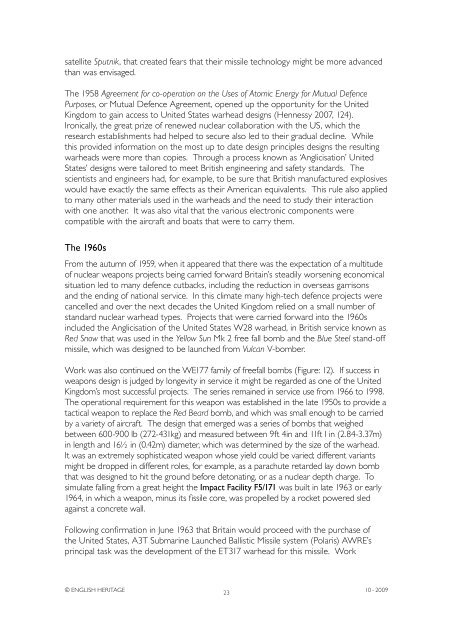Atomic Weapons Research Establishment. Orford ... - English Heritage
Atomic Weapons Research Establishment. Orford ... - English Heritage
Atomic Weapons Research Establishment. Orford ... - English Heritage
You also want an ePaper? Increase the reach of your titles
YUMPU automatically turns print PDFs into web optimized ePapers that Google loves.
satellite Sputnik, that created fears that their missile technology might be more advanced<br />
than was envisaged.<br />
The 1958 Agreement for co-operation on the Uses of <strong>Atomic</strong> Energy for Mutual Defence<br />
Purposes, or Mutual Defence Agreement, opened up the opportunity for the United<br />
Kingdom to gain access to United States warhead designs (Hennessy 2007, 124).<br />
Ironically, the great prize of renewed nuclear collaboration with the US, which the<br />
research establishments had helped to secure also led to their gradual decline. While<br />
this provided information on the most up to date design principles designs the resulting<br />
warheads were more than copies. Through a process known as ‘Anglicisation’ United<br />
States’ designs were tailored to meet British engineering and safety standards. The<br />
scientists and engineers had, for example, to be sure that British manufactured explosives<br />
would have exactly the same effects as their American equivalents. This rule also applied<br />
to many other materials used in the warheads and the need to study their interaction<br />
with one another. It was also vital that the various electronic components were<br />
compatible with the aircraft and boats that were to carry them.<br />
The 1960s<br />
From the autumn of 1959, when it appeared that there was the expectation of a multitude<br />
of nuclear weapons projects being carried forward Britain’s steadily worsening economical<br />
situation led to many defence cutbacks, including the reduction in overseas garrisons<br />
and the ending of national service. In this climate many high-tech defence projects were<br />
cancelled and over the next decades the United Kingdom relied on a small number of<br />
standard nuclear warhead types. Projects that were carried forward into the 1960s<br />
included the Anglicisation of the United States W28 warhead, in British service known as<br />
Red Snow that was used in the Yellow Sun Mk 2 free fall bomb and the Blue Steel stand-off<br />
missile, which was designed to be launched from Vulcan V-bomber.<br />
Work was also continued on the WE177 family of freefall bombs (Figure: 12). If success in<br />
weapons design is judged by longevity in service it might be regarded as one of the United<br />
Kingdom’s most successful projects. The series remained in service use from 1966 to 1998.<br />
The operational requirement for this weapon was established in the late 1950s to provide a<br />
tactical weapon to replace the Red Beard bomb, and which was small enough to be carried<br />
by a variety of aircraft. The design that emerged was a series of bombs that weighed<br />
between 600-900 lb (272-431kg) and measured between 9ft 4in and 11ft I in (2.84-3.37m)<br />
in length and 16½ in (0.42m) diameter, which was determined by the size of the warhead.<br />
It was an extremely sophisticated weapon whose yield could be varied; different variants<br />
might be dropped in different roles, for example, as a parachute retarded lay down bomb<br />
that was designed to hit the ground before detonating, or as a nuclear depth charge. To<br />
simulate falling from a great height the Impact Facility F5/171 was built in late 1963 or early<br />
1964, in which a weapon, minus its fissile core, was propelled by a rocket powered sled<br />
against a concrete wall.<br />
Following confirmation in June 1963 that Britain would proceed with the purchase of<br />
the United States, A3T Submarine Launched Ballistic Missile system (Polaris) AWRE’s<br />
principal task was the development of the ET317 warhead for this missile. Work<br />
© ENGLISH HERITAGE<br />
23<br />
10 - 2009

















